

Figure. Left-side view of H. reversa, 59 mm ML, central North Atlantic, R/V G.O. SARS, MarEco cruise. Photograph by R. Young.
- Photophores
- Compound photophores of large and small size intermixed on ventral surface of mantle.
- Compound photophores number usually 18 (17 large + 1 small) on right eyelid (right drawing). Compare with photophores on left eyelid (left drawing).
- Arms IV with 4 longitudinal series on arm base (3 series of large organs, dorsal series of small organs). In the photograph, the arrows point to 4 photophores in the dorsal series.
- Arms and Web
- Inner web low or nearly absent; outer web absent.
- Subequal; length 100-150% of ML (arms proportionally smaller in mature females).
- Suckers of arms I-III with 4-10 broad, rounded blunt or pointed teeth on distal margin; larger squid have smooth rings; distal suckers often more distinctly toothed.
- Tentacles
- Manus with suckers in 5-6 series.
- Four median suckers 3-4 times larger than suckers of marginal series.
- Largest club sucker sometimes with irregular dentition (left drawing); other suckers of manus with many blunt or pointed teeth around entire margin (right drawing).
- Buccal crown
- Buccal crown with 7 supports.
- Funnel organ
- Each lateral arm of dorsal pad generally with low median ridge.
- Fins
- Length 35-50% of ML; width 40-60% of ML (fins proportionally smaller in mature females).
- Reproductive structures
- Spermatophores
- Length 2.4-4.1% of ML; sperm mass 4-25% (Atlantic) or 30-34% (Mediterranean) of spermatophore length (SpL); cement body 56-83% (Atlantic) or 43-47% (Mediterranean) of SpL; ejaculatory apparatus 13-20% (Atlantic) or 20-21% (Mediterranean). Ejaculatory apparatus with a single, long loop. Connective complex short.
- Hectocotylus
- Suckers on bases of all arms with swollen collars in mature males. Both arms I modified. Ends of arms I with equal-sized suckers on enlarged pedestals.



Figure. Ventral view of mantle of H. reversa. Left - 39 mm ML. Drawing extracted from Fig. 11a of Voss (1969). Right - 29 mm ML, central North Atlantic, R/V G.O. SARS, MarEco cruise. Photograph by R. Young.

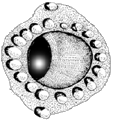
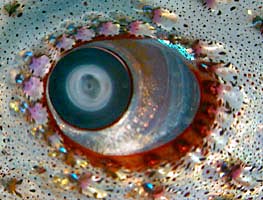
Figure. Right eyelids of H. reversa. Left - 29 mm ML male, 41°N, 28°W. Drawings from Voss (1969, fig. 14d, e). Right - 59 mm ML, central North Atlantic, R/V G.O. SARS, MarEco cruise. Photograph by R. Young.


Figure. Ventral view of arm IV of H. reversa, 39 mm ML, 41°N, 28°W. Drawing from Voss (1969, fig. 14a).

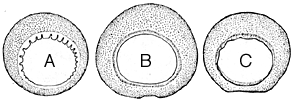
Figure. Oral views of arm suckers of H. reversa. A - Sucker from row 13, arm IV of specimen from off Blanes, Spain. B - Sucker from row 13, arm II of same specimen. C - Sucker from row 10 arm II, 39 mm ML, 41°N, 28°W. Drawings from Voss (1969, fig. 14c, e, f).


Figure. Oral view of club of H. reversa, 29 mm ML, 29 mm ML male, 41°N, 28°W. Drawing from Voss (1969, fig. 11b).
Comments
This description is from Voss (1969) and Voss, et al. (1998). Drawings by Voss (1969) printed with the Permission of the Bulletin of Marine Science.
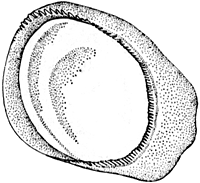
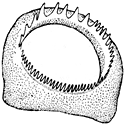






 Go to quick links
Go to quick search
Go to navigation for this section of the ToL site
Go to detailed links for the ToL site
Go to quick links
Go to quick search
Go to navigation for this section of the ToL site
Go to detailed links for the ToL site